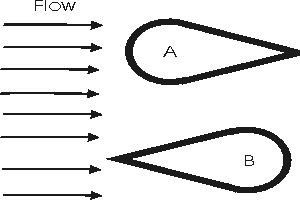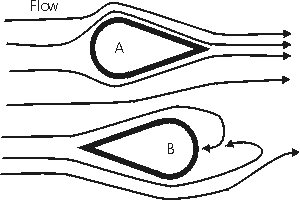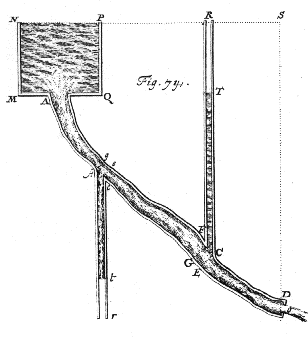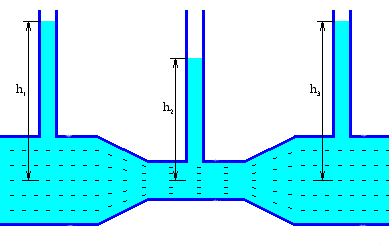Gravity Concentration 5
Now I have given the quick overview we need to look at basic principles, and I will design the efficient sluice.
Fluid Flow:
Fluid flow is not very intuitive. In fact it is darn right confusing. I find this surprising. Billions of years of evolution have formed us and physics has never changed. You would think that any physical property in the world around us would make immediate sense. I guess that humans tend not to be a very observant lot. Only during the last split second of the human experience have we realized that the world is flat, that the sun and the heavens revolve around the earth in complex patterns, and that there is a giant hole to the centre of the world if you go far enough north. Magic is real, Elvis is alive, global warming is caused by bovine flatulence, and if you take something on faith and read it in a book or on the internet it has to be true.
What sounds and appears like true is not necessarily the whole truth.
The best example of fluid flow that brought dynamics home to me was dragging an empty tire innertube behind my boat. I thought it would travel much like an innertube on ice. There would be no drag and the tube would flutter across the surface as it was so light. But no! what incredible drag! I might as well have been pulling an anchor. You can also see this effect pulling an empty canoe or boat. They all want to squat down into the water, rather than plane on the top.


Which object will exhibit the lesser drag force to the flow? You would think that it would be B as it has that nice pointy bit cutting the flow. It turns out that the low pressure area on the downwind side has far more influence on the drag forces than does the high pressure side. A is far better.
The strange properties of fluid flow make the pitot tube work, and make cooling towers on generation stations look so weird. Their shape has been dictated by aerodynamics. It is hard to believe that it is far better to streamline an object on the downwind side rather than the upwind side. A knife edge into the wind is not nearly as effective as a knife edge on the down wind side. The reason is that flow against an object does not cause an increase of pressure on the upwind side. The pressure of the media on the upwind side is equal on the entire upwind side. This stays true until until you reach the speed of sound in the medium. The compression wave on the upstream side travels at the speed of sound. Movement however, does cause a decrease in pressure on the downwind side and any turbulence greatly increases this effect, so smooth on the downwind side is the winner. Turbulent flow causes far greater drag than laminar flow.

Air flow through the radiator on your car would be far better and more efficient with the radiator at the back of your car rather than the front. The reason that designers place the rad at the front of the car has nothing to do with flow or efficiency, everyone figures that it just looks better that way.


.
This rather strange effect was first described by Daniel Bernoulli. He was a mathematician in the early 1700's. He is commonly referred to as a polymath or renaissance man as he was interested in and studied just about everything. He is famous for his study of the flow of water. He worked out the relationships between flow pressure and flow volume and static head with an understanding of the conservation of energy. Smart guy..


Mr. Bernoulli's drawing is on the left and a more structured one is on the right. If we look at the right we can see that there is flow.
One would normally expect that the center area would be squished by the sides and that the pressure would be higher, but that is not how flow works.
The pressures are different in the three vertical sections. The reason is that the water flow has to speed up in the smaller section. Water is virtually incompressible, therefore to have the same volume of flow in the larger sections as the narrower, the water flow has to speed up.
If the flow is 1 gallon a second then it is one gallon a second in each section. The velocity has to be faster in the narrow section.
To follow the law of conservation of energy means that the energy for this increase in velocity had to come from somewhere and the only place is from the pressure head. There are equations and tables available to be able to predict with some degree of accuracy this flow, velocity and pressure in any arbitrary pipe or channel.
Another great fluids researcher was Osbourne Reynolds. He studied the mathematics behind the differences and relationships of laminar and turbulent flow. With low Reynolds numbers viscosity is the most important determining factor in the flow regime and the flow is laminar. With increasing velocity, density or characteristic length, the reynolds number is higher, the inertia of the fluid becomes more important than the viscosity forces and the flow is turbulent.
 Good movie of some Bernoulli experiments.
Good movie of some Bernoulli experiments.
Another way to visualize this phenomena is to get yourself a party balloon and a straw. Inflate the balloon and then blow air at the balloon using the straw. If you blow on the side of the balloon the balloon will travel to the air flow, very amusing and counter intuitive.
The physics of flow have to be understood and used properly when designing a gravity concentration device. To work well you have to design with nature and not against it.
